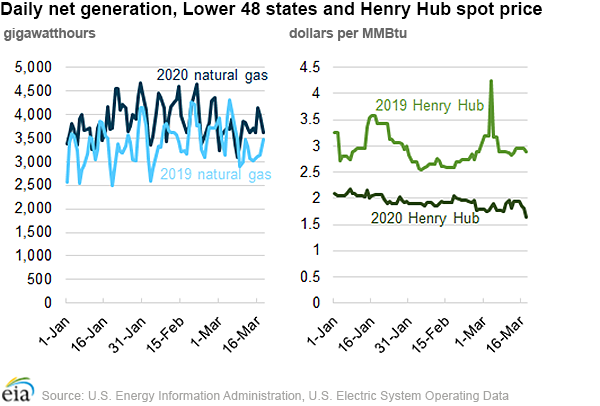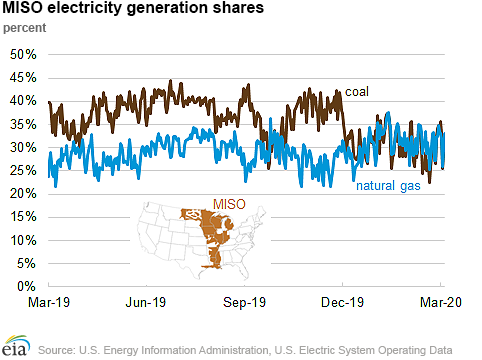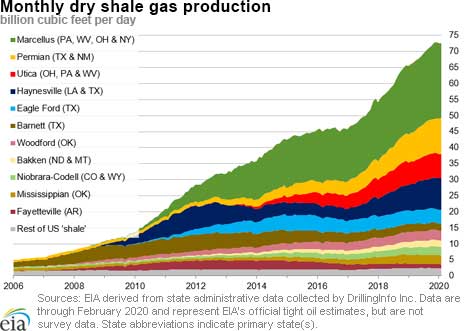In the News:
Low natural gas prices and capacity additions drive 2020 power burn growth in the first quarter
EIA’s Hourly Electric Grid Monitor shows that year-to-date natural gas-fired power generation grew in 2020 compared to year-ago levels for the same time period. Natural gas-fired power plants generated a cumulative 301,100 gigawatthours (GWh) of electricity in 2020 through March 18, an increase of 12% compared to 2019 (excluding the additional leap day in 2020). The growth of natural gas-fired generation occurred despite a 5% decline in total electricity generation as a result of a warmer-than-average winter that reduced electric heating demand. This growth was driven primarily by low natural gas prices and capacity additions that occurred in 2019.
Beginning in late 2019, with warmer-than-average winter temperatures and strong natural gas production, the Henry Hub natural gas spot price fell from $2.87 per million British thermal units (MMBtu) on November 7 to an average of $1.94/MMBtu so far in 2020. The relatively low price environment that has persisted for the first three months of 2020 has made natural gas a more competitive fuel source.
As natural gas generation has increased, coal-fired generation has declined by an average of 965 GWh per day in 2020, compared to the same time period last year. Coal-to-gas switching has been particularly noticeable in the Midcontinent Independent System Operator (MISO), which covers much of the U.S. Midwest and part of the Gulf Coast. In MISO, the share of coal-fired generation has typically exceeded the share of natural gas-fired generation during the past two years, aside from infrequent occurrences, such as in October 2019 when natural gas and coal-fired generation shares were equal for a few weeks. However, since the start of the year, the share of natural gas-fired generation has been about the same as the share of coal-fired generation as the Chicago Citygate spot price approached $2.00/MMBtu. Other market forces also influenced the recent changes in the shares of natural gas and coal-fired generation in MISO, such as growth in wind and nuclear generation in 2020.
Capacity additions over the past year have also contributed to the growth in natural gas-fired generation across the Lower 48 states. According to EIA’s Electric Power Monthly, the United States added a net 6,674 MW of new combined-cycle capacity in 2019. The growth in capacity is expected to continue with another net 5,840 MW of combined-cycle capacity planned for 2020.
Overview:
(For the week ending Wednesday, March 25, 2020)
- Natural gas spot prices rose at most locations this report week (Wednesday, March 18, to Wednesday, March 25). The Henry Hub spot price rose from $1.65 per million British thermal units (MMBtu) last Wednesday to $1.71/MMBtu yesterday.
- At the New York Mercantile Exchange (Nymex), the price of the April 2020 contract increased 6¢, from $1.604/MMBtu last Wednesday to $1.659/MMBtu yesterday. The price of the 12-month strip averaging April 2020 through March 2021 futures contracts climbed 10¢/MMBtu to $2.179/MMBtu.
- The net withdrawal from working gas totaled 29 billion cubic feet (Bcf) for the week ending March 20. Working natural gas stocks total 2,005 Bcf, which is 79% more than the year-ago level and 17% more than the five-year (2015–19) average for this week.
- The natural gas plant liquids composite price at Mont Belvieu, Texas, fell by 71¢/MMBtu, averaging $2.40/MMBtu for the week ending March 25. The prices of butane, natural gasoline, isobutane, propane, and ethane all fell, by 30%, 27%, 24%, 22%, and 18%, respectively. The deep decline in crude oil prices is a primary driver for the discounting across all hydrocarbon gas liquids.
- According to Baker Hughes, for the week ending Tuesday, March 17, the natural gas rig count decreased by 1 to 106. The number of oil-directed rigs fell by 19 to 664. The total rig count decreased by 20, and it now stands at 772.
Prices/Supply/Demand:
Prices rise at most locations. This report week (Wednesday, March 18, to Wednesday, March 25), the Henry Hub spot price rose 6¢ from $1.65/MMBtu last Wednesday to a high of $1.71/MMBtu yesterday. Temperatures were generally close to normal across most of the Lower 48 states and slightly warmer than normal along the eastern seaboard. At the Chicago Citygate, the price increased 4¢ from a low of $1.49/MMBtu last Wednesday to $1.53/MMBtu yesterday.
California prices fall. The price at PG&E Citygate in Northern California fell 41¢, down from a high of $2.80/MMBtu last Wednesday to $2.39/MMBtu yesterday. The price at SoCal Citygate in Southern California decreased 20¢ from a high of $2.11/MMBtu last Wednesday to $1.91/MMBtu yesterday as net withdrawals from storage were minimal from Friday through the end of the report week.
Northeast prices rise. Temperatures in the Northeast were seasonal for this time of year and colder week on week, leading to increased prices in demand markets. At the Algonquin Citygate, which serves Boston-area consumers, the price went up 13¢ from $1.42/MMBtu last Wednesday to $1.55/MMBtu yesterday. At the Transcontinental Pipeline Zone 6 trading point for New York City, the price increased 8¢ from $1.30/MMBtu last Wednesday to $1.38/MMBtu yesterday.
The Tennessee Zone 4 Marcellus spot price increased 13¢ from $1.19/MMBtu last Wednesday to $1.32/MMBtu yesterday. The price at Dominion South in southwest Pennsylvania rose 8¢ from $1.23/MMBtu last Wednesday to $1.31/MMBtu yesterday.
Permian Basin prices fall, widening the basis to the Henry Hub. The price at the Waha Hub in West Texas, which is located near Permian Basin production activities, averaged $0.89/MMBtu last Wednesday, 76¢/MMBtu lower than the Henry Hub price. Yesterday, the price at the Waha Hub averaged $0.29/MMBtu, $1.42/MMBtu lower than the Henry Hub price. Prices reached a weekly low of $0.04/MMBtu on Tuesday. Takeaway capacity out of the Permian Basin was restricted by maintenance activity on the Gulf Coast Express pipeline on Wednesday, March 25, according to Kinder Morgan, putting downward pressure on prices.
Supply is flat. According to data from IHS Markit, the average total supply of natural gas remained the same as in the previous report week, averaging 98.9 Bcf/d. Dry natural gas production remained unchanged week over week. Average net imports from Canada increased by 6% from last week.
Demand falls, driven by power generation. Total U.S. consumption of natural gas fell by 1% compared with the previous report week, according to data from IHS Markit. Natural gas consumed for power generation declined by 2% week over week. Industrial sector consumption decreased by 2% week over week. In the residential and commercial sectors, consumption remained at last week's level, averaging 27.2 Bcf/d. Natural gas exports to Mexico increased 1%.
U.S. LNG exports decrease week over week. Fifteen LNG vessels (seven from Sabine Pass, three from Freeport, two each from Cameron and Corpus Christi, and one from Cove Point) with a combined LNG-carrying capacity of 55 Bcf departed the United States between March 19 and March 25, 2020, according to shipping data provided by Marine Traffic.
Storage:
The net withdrawal from storage totaled 29 Bcf for the week ending March 20, compared with the five-year (2015–19) average net withdrawal of 40 Bcf and last year's net withdrawal of 39 Bcf during the same week. Working natural gas stocks totaled 2,005 Bcf, which is 292 Bcf more than the five-year average and 888 Bcf more than last year at this time.
According to The Desk survey of natural gas analysts, estimates of the weekly net change to working natural gas stocks ranged from a net withdrawal of 14 Bcf to 36 Bcf, with a median estimate of 24 Bcf.
The average rate of withdrawal from storage is 13% lower than the five-year average so far in the withdrawal season (November through March). If the rate of withdrawal from storage matched the five-year average of 1.4 Bcf/d for the remainder of the withdrawal season, the total inventory would be 1,989 Bcf on March 31, which is 292 Bcf higher than the five-year average of 1,697 Bcf for that time of year.
More storage data and analysis can be found on the Natural Gas Storage Dashboard and the Weekly Natural Gas Storage Report.
See also:
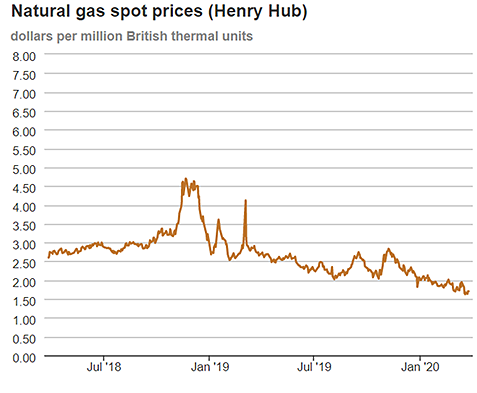
| Spot Prices ($/MMBtu) | Thu, 19-Mar |
Fri, 20-Mar |
Mon, 23-Mar |
Tue, 24-Mar |
Wed, 25-Mar |
|---|---|---|---|---|---|
| Henry Hub |
1.63 |
1.68 |
1.64 |
1.71 |
1.71 |
| New York |
1.24 |
1.51 |
1.41 |
1.66 |
1.38 |
| Chicago |
1.53 |
1.55 |
1.49 |
1.54 |
1.53 |
| Cal. Comp. Avg.* |
1.98 |
1.84 |
1.77 |
1.84 |
1.80 |
| Futures ($/MMBtu) | |||||
| April contract | 1.654 |
1.604 |
1.602 |
1.653 |
1.659 |
| May contract |
1.726 |
1.675 |
1.673 |
1.729 |
1.714 |
| *Avg. of NGI's reported prices for: Malin, PG&E Citygate, and Southern California Border Avg. | |||||
| Source: NGI's Daily Gas Price Index | |||||
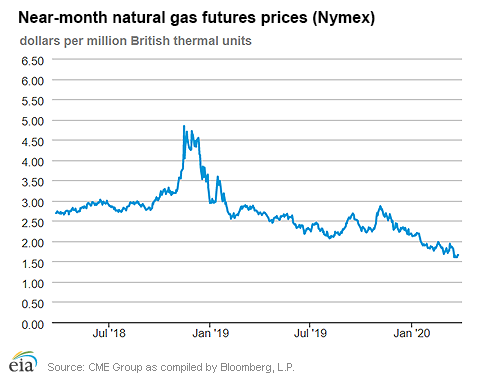
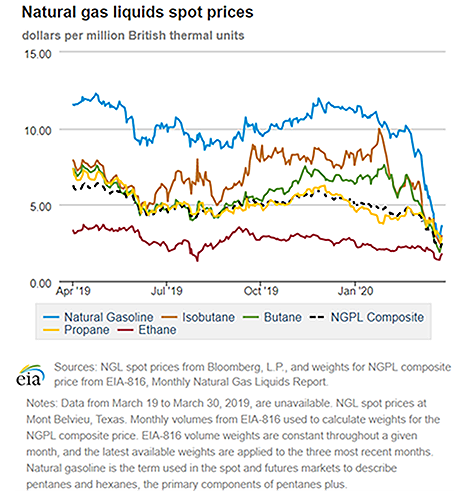
| U.S. natural gas supply - Gas Week: (3/19/20 - 3/25/20) | |||
|---|---|---|---|
Average daily values (Bcf/d): |
|||
this week |
last week |
last year |
|
| Marketed production | 106.4 |
106.7 |
101.6 |
| Dry production | 94.5 |
94.8 |
90.0 |
| Net Canada imports | 4.3 |
4.1 |
4.8 |
| LNG pipeline deliveries | 0.1 |
0.1 |
0.1 |
| Total supply | 98.9 |
99.0 |
94.9 |
|
Source: IHS Markit | |||
| U.S. natural gas consumption - Gas Week: (3/19/20 - 3/25/20) | |||
|---|---|---|---|
Average daily values (Bcf/d): |
|||
this week |
last week |
last year |
|
| U.S. consumption | 82.3 |
83.5 |
80.8 |
| Power | 29.8 |
30.3 |
24.3 |
| Industrial | 25.3 |
25.9 |
24.3 |
| Residential/commercial | 27.2 |
27.3 |
32.2 |
| Mexico exports | 5.6 |
5.5 |
4.7 |
| Pipeline fuel use/losses | 7.0 |
7.0 |
6.7 |
| LNG pipeline receipts | 9.2 |
8.0 |
4.6 |
| Total demand | 104.0 |
104.0 |
96.8 |
|
Source: IHS Markit | |||
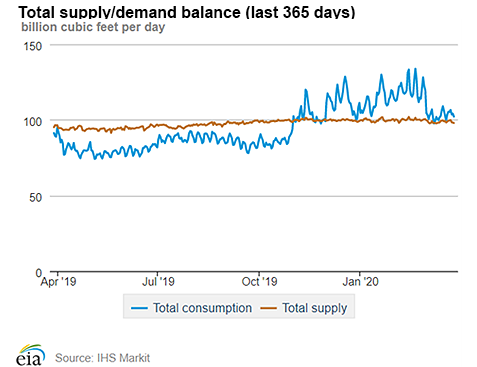
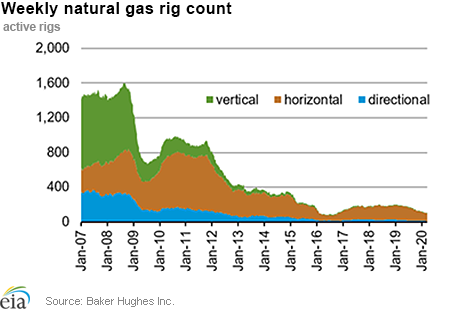
| Rigs | |||
|---|---|---|---|
Tue, March 17, 2020 |
Change from |
||
last week |
last year |
||
| Oil rigs | 664 |
-2.8% |
-19.4% |
| Natural gas rigs | 106 |
-0.9% |
-44.8% |
| Note: Excludes any miscellaneous rigs | |||
| Rig numbers by type | |||
|---|---|---|---|
Tue, March 17, 2020 |
Change from |
||
last week |
last year |
||
| Vertical | 0 |
0.0% |
0.0% |
| Horizontal | 9 |
0.0% |
-60.9% |
| Directional | 49 |
2.1% |
-22.2% |
| Source: Baker Hughes Inc. | |||
| Working gas in underground storage | ||||
|---|---|---|---|---|
Stocks billion cubic feet (Bcf) |
||||
| Region | 2020-03-20 |
2020-03-13 |
change |
|
| East | 398 |
412 |
-14 |
|
| Midwest | 492 |
512 |
-20 |
|
| Mountain | 92 |
96 |
-4 |
|
| Pacific | 194 |
199 |
-5 |
|
| South Central | 829 |
814 |
15 |
|
| Total | 2,005 |
2,034 |
-29 |
|
|
Source: Form EIA-912, Weekly Underground Natural Gas Storage Report | ||||
| Working gas in underground storage | |||||
|---|---|---|---|---|---|
Historical comparisons |
|||||
Year ago (3/20/19) |
5-year average (2015-2019) |
||||
| Region | Stocks (Bcf) |
% change |
Stocks (Bcf) |
% change |
|
| East | 231 |
72.3 |
301 |
32.2 |
|
| Midwest | 254 |
93.7 |
379 |
29.8 |
|
| Mountain | 62 |
48.4 |
110 |
-16.4 |
|
| Pacific | 102 |
90.2 |
201 |
-3.5 |
|
| South Central | 468 |
77.1 |
723 |
14.7 |
|
| Total | 1,117 |
79.5 |
1,713 |
17.0 |
|
| Source: Form EIA-912, Weekly Underground Natural Gas Storage Report | |||||
| Temperature – heating & cooling degree days (week ending Mar 19) | ||||||||
|---|---|---|---|---|---|---|---|---|
HDD deviation from: |
CDD deviation from: |
|||||||
| Region | HDD Current |
normal |
last year |
CDD Current |
normal |
last year |
||
| New England | 172 |
-29 |
-15 |
0 |
0 |
0 |
||
| Middle Atlantic | 148 |
-38 |
-19 |
0 |
0 |
0 |
||
| E N Central | 177 |
-19 |
-7 |
0 |
0 |
0 |
||
| W N Central | 193 |
-2 |
2 |
0 |
-1 |
0 |
||
| South Atlantic | 65 |
-44 |
-40 |
21 |
10 |
9 |
||
| E S Central | 64 |
-40 |
-45 |
7 |
2 |
5 |
||
| W S Central | 30 |
-32 |
-46 |
30 |
18 |
27 |
||
| Mountain | 159 |
2 |
-11 |
0 |
-2 |
-2 |
||
| Pacific | 130 |
40 |
58 |
0 |
-1 |
0 |
||
| United States | 133 |
-14 |
-6 |
8 |
4 |
5 |
||
|
Note: HDD = heating degree day; CDD = cooling degree day Source: National Oceanic and Atmospheric Administration | ||||||||
Average temperature (°F)
7-day mean ending Mar 19, 2020
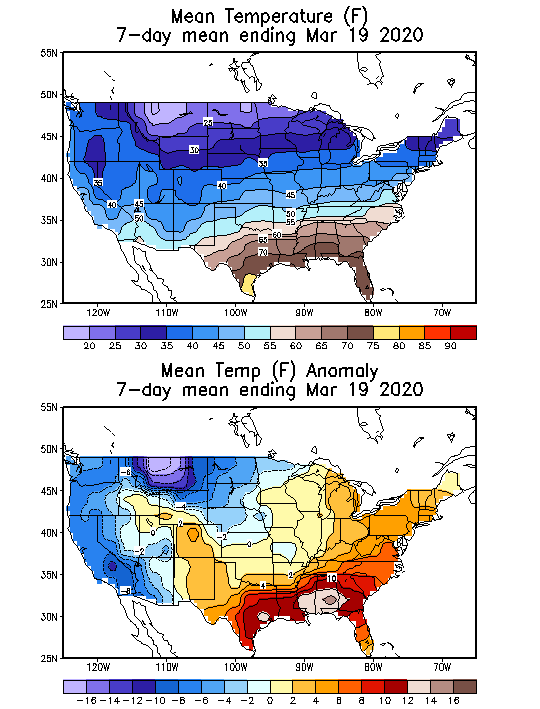
Source: National Oceanic and Atmospheric Administration
Deviation between average and normal (°F)
7-day mean ending Mar 19, 2020

Source: National Oceanic and Atmospheric Administration

